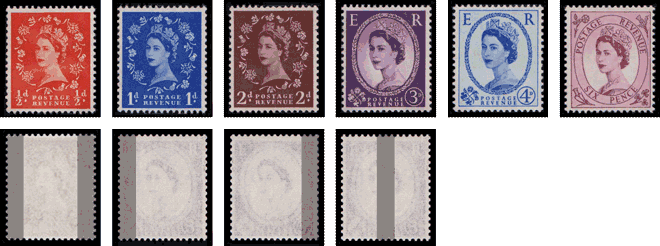
Stamps with phosphor bands were introduced in 1960. The lines were initially 5/16″ (8 mm) wide, later widened to 3/8″ (9.5 mm), and applied to the front of the stamps. Three types of phosphor were used, known as green, blue, and violet. Harrison called these phosphors: Lettalite B, Lettalite B2, Lettalite B3. There was never a Lettalite A. The “B” represented “Blue”, it was not a letter in a sequence.
The first leaders inherited the “LINE STAMPS” overprint from the graphite issue, but with the introduction of blue and violet phosphors, the overprint changed to variations on “BLUE PHOS” and “B3 PHOS”, where “B3” indicated Lettalite B3.
Initially there were two phosphor bands per stamp, with a single band on the 2d value for the printed paper rate (PPR). This rate was increased to 2½d on 1 October 1961 and so the 2d changed to two bands. There were no 2½d phosphor rolls issued. On 17 May 1965 the printed paper rate increased again to 3d, and thus 3d rolls were switched to a single band.
All stamps below had two phosphor bands (2b) unless noted otherwise: (cb) centre band, (lb) left band, or (lrb) left band on even and right band on odd numbered rolls.
Green Phosphor

OP2

OP3
Leaders were overprinted “LINE STAMPS”: OP2 (24mm), or OP3 (14mm). OP2 was handstamped in black, OP3 was by letterpress in black or red. For use in Post Office vending machines.
| E | 1d | 480 | £2 | Lower End | Blue/White | c | OP:3r |
| G | ½d | 480 | £1 | Lower End | Orange/White | c | 2b |
| V | 2d | 960 | £8 | Lower End | Brown/White | 20 lb | 2b |
| W | ½d | 960 | £2 | Lower End | Orange/White | c | 3r |
| X | 1d | 960 | £4 | Lower End | Blue/White | c | 3b |
| Y | ½d | 1,920 | £4 | Lower End | Orange/White | c 20 * | 3r |
| Z | 1d | 1,920 | £8 | Lower End | Blue/White | c | 3r |
c: continuous csw: continuous sideways 12/20: strips
* second issue July 1961 made from strips of 20.
All with two phosphor bands (2b) unless noted (lb) left band.
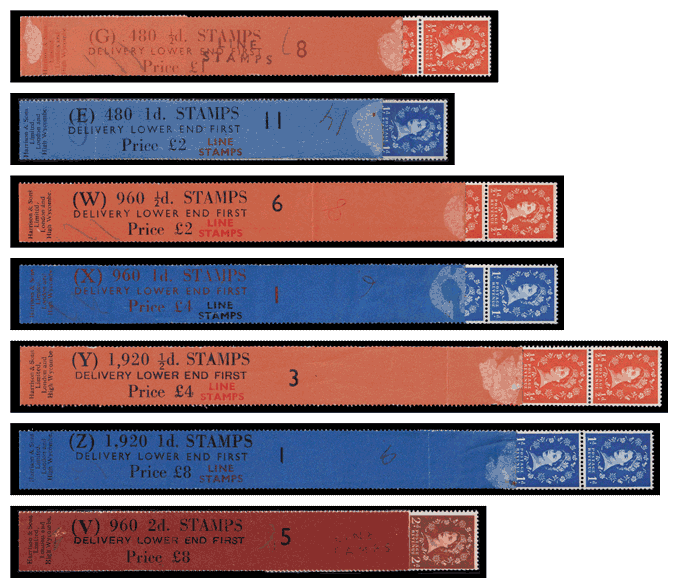
Blue Phosphor

OP4

OP5

OP10
Leaders were overprinted “BLUE PHOS” (OP4) in red, or “PHOS” (OP5) in black or red OP10 with “B3” deleted in manuscript [not listed, seen on (X) 2b blue phosphor, whiter paper]. For use in Post Office vending machines.
| E | 1d | 480 | £2 | Lower End | Blue/White | c | OP:4r |
| G | ½d | 480 | £1 | Lower End | Orange/White | c | 4r 5b |
| U | 3d | 1,920 | £24 | Lower End | Buff | c 2b lrb | 4r 5r |
| V | 2d | 960 | £8 | Lower End | Brown/White | c lb 2b | 4r |
| W | ½d | 960 | £2 | Lower End | Orange/White | c | 4r |
| X | 1d | 960 | £4 | Lower End | Blue/White | c | 4r 10r |
| Y | ½d | 1,920 | £4 | Lower End | Orange/White | c | 4r |
| Z | 1d | 1,920 | £8 | Lower End | Blue/White | c | 4r |
| AC | 3d | 480 | £6 | Lower End | Buff | c 2b lrb | 4r |
| AD | 3d | 960 | £12 | Lower End | Buff | c 2b lrb | 4r |
2b: two bands lb: left band cb: centre band.
lrb: left band on even and right band on odd numbered rolls.
All with stamps printed on Cream paper, or on Whiter paper from 1962, except: (W) is Cream paper only.
| AC | 3d | 480 | £6 | Lower End | Cream/White | c | OP:4r |
| AD | 3d | 960 | £12 | Lower End | Cream/White | c | 4r |
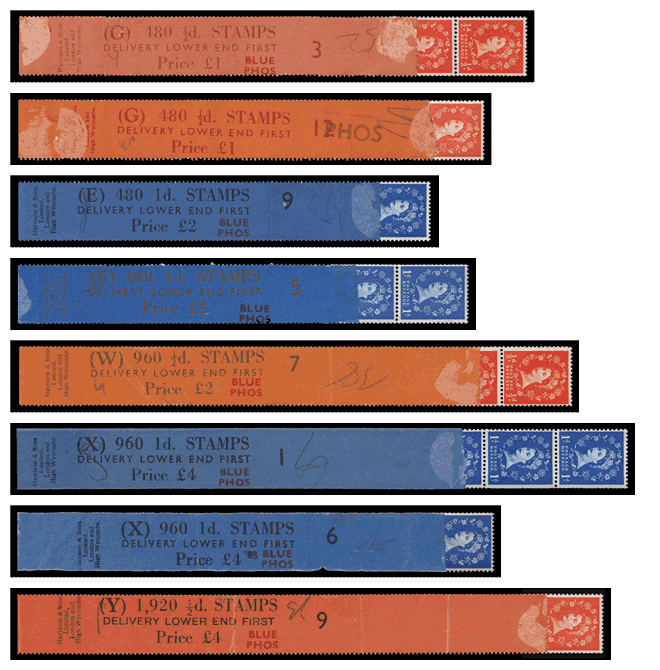
(V) rolls with left band, then two bands (PPR changed Oct 1961):

(U, AC, AD) rolls with two bands, then left or right band (PPR changed May 1965):

Perforated cream/white leaders, two bands:

Violet Phosphor

OP4

OP8

OP6

OP9

OP7
Leaders were overprinted “BLUE PHOS”, “B3”, “B3 BLUE PHOS”, or “B3 PHOS”, OP9 with “B3” added in manuscript [not listed, seen on (Z) 2b violet 8mm phosphor].
| E | 1d | 480 | £2 | Lower End | Blue/White | c | OP:7r |
| G | ½d | 480 | £1 | Lower End | Orange/White | c | 8r |
| U | 3d | 1,920 | £24 | Lower End | Buff | c lrb | 4r 7r |
| V | 2d | 960 | £8 | Lower End | Brown/White | c | 7r 8r |
| W | ½d | 960 | £2 | Lower End | Orange/White | c | 6b+4r 7r |
| X | 1d | 960 | £4 | Lower End | Blue/White | c | 7r 8r |
| Y | ½d | 1,920 | £4 | Lower End | Orange/White | c | 8r |
| Z | 1d | 1,920 | £8 | Lower End | Blue/White | c | 7r 9r |
| AC | 3d | 480 | £6 | Lower End | Buff | c lrb | 7r 8r |
| AD | 3d | 960 | £12 | Lower End | Buff | c lrb | 7r 8r |
lrb: left band on even and right band on odd numbered rolls.
| E | 1d | 480 | £2 | Lower End | Blue/White | c | OP:8r — |
| H | 4d | 480 | £8 | Left Side | Buff | csw | 8r |
| J | 6d | 480 | £12 | Lower End | Pink | c | — |
| R | 2d | 480 | £4 | Top End | Brown/White | c | — |
| S | 3d | 480 | £6 | Left Side | Buff | csw cb | 8r |
| T | 2d | 480 | £4 | Left Side | Buff | csw | 8r |
| V | 2d | 960 | £8 | Lower End | Brown/White | c | 8r |
| X | 1d | 960 | £4 | Lower End | Blue * | c | 8r |
| Z | 1d | 1,920 | £8 | Lower End | Blue * | c | 8r |
| AC | 3d | 480 | £6 | Lower End | Buff | c cb | 8r |
| AD | 3d | 960 | £12 | Lower End | Buff | c cb | 8r — |
* blue/white, or blue-grey throughout (both OP8r).
Rolls for use in Post Office vending machines (GEWXYZVU, AC, AD) have 480, 960 or 1,920 stamps wound lengthways, facing inwards, onto ¾” diameter cores, for delivery lower end first.
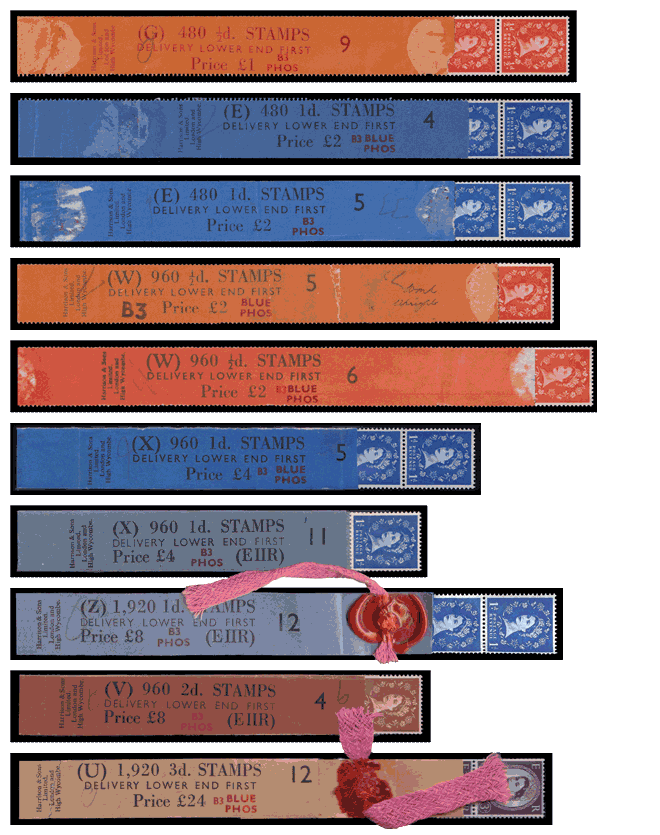
(AC) and (AD) rolls with “(EIIR)”, centre band:

POKO Affixing Machines
Rolls for use in POKO affixing machines (J) have 480 stamps wound lengthways, facing outwards, onto 1¼” diameter cores, for delivery lower end first.

FIXO Affixing Machines
Rolls for use in FIXO affixing machines (R) have 480 stamps wound lengthways, facing outwards, onto ½” diameter cores, for delivery top end first.

Some (R) rolls are known with stamps attached for lower end delivery. Perhaps there was still some demand for 2d POKO rolls after (Q) rolls had been discontinued?

Multipost Affixing Machines
Rolls for use in Multipost affixing machines (TSH) have 480 stamps wound sideways, facing outwards, onto ½” diameter cores, for delivery left side first. Some (H) rolls were also used in a prototype Post Office vending machine at Cannon St, London which delivered three 4d stamps for one shilling.
Continuously printed, watermark sideways (TSH):
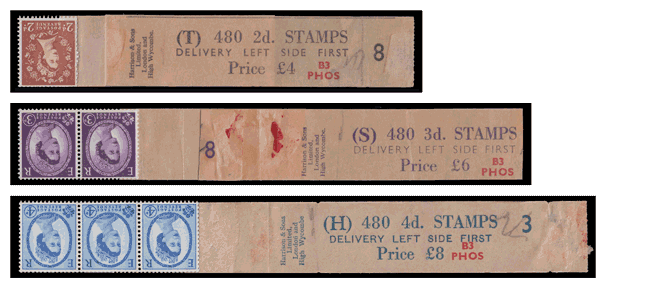
Next: Machin